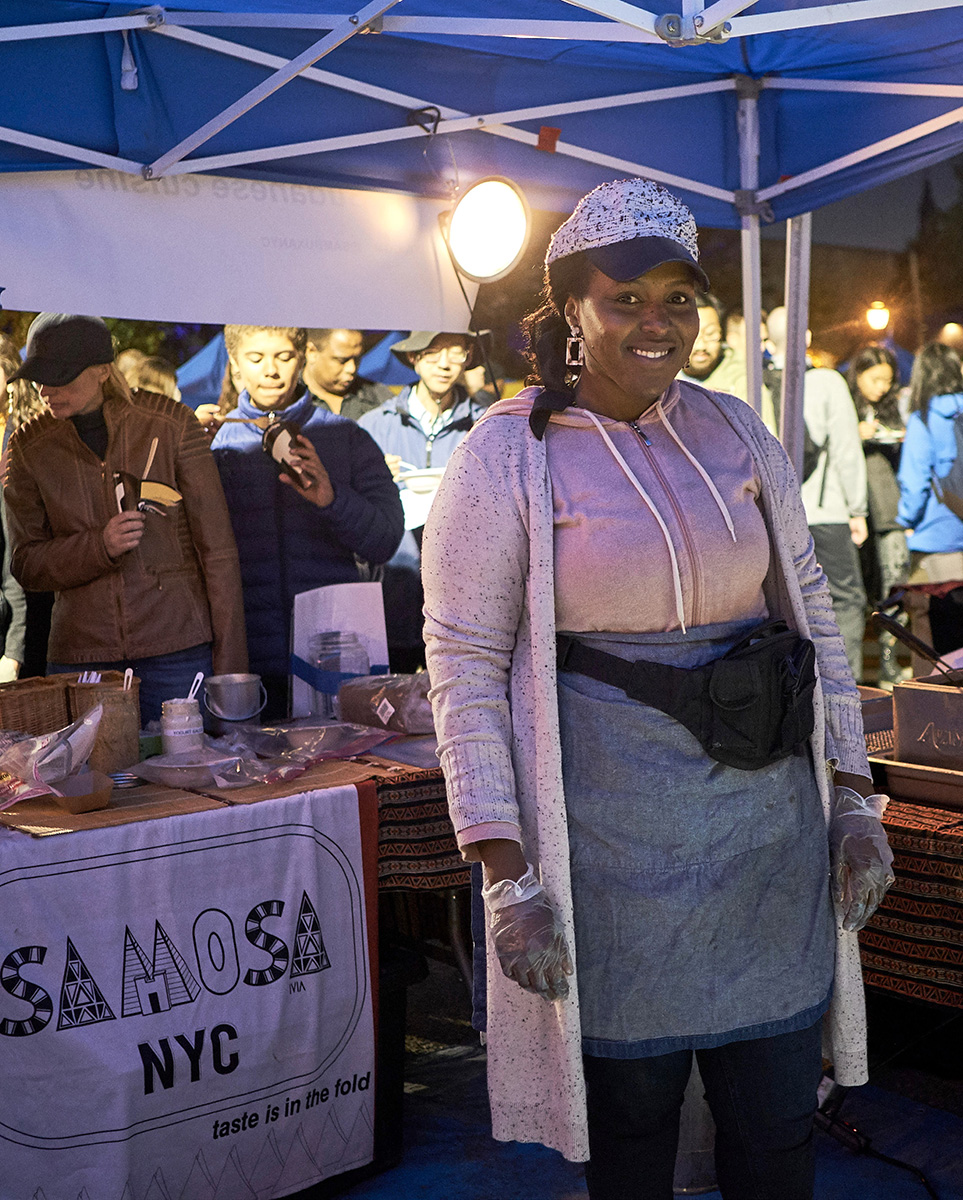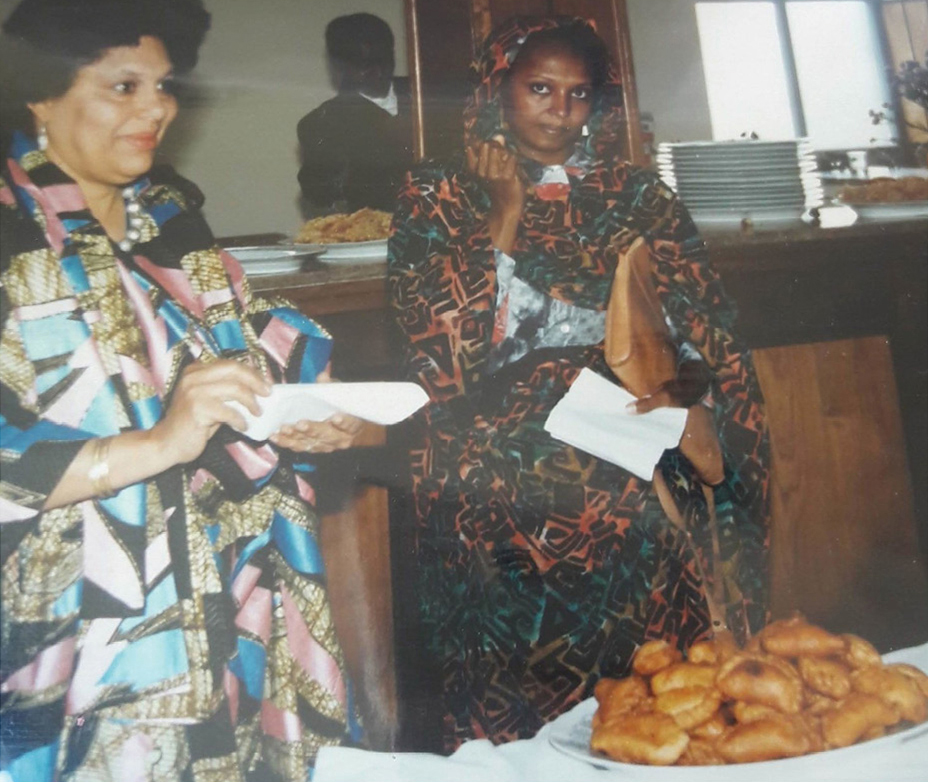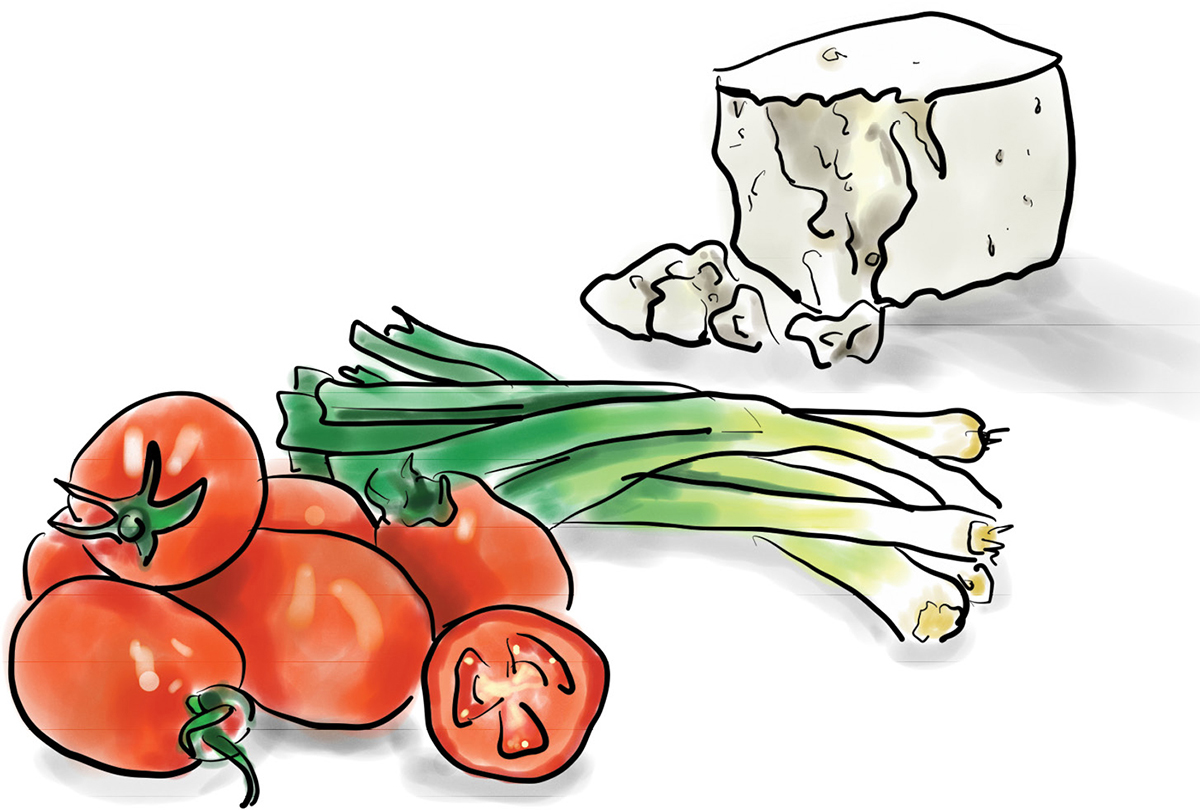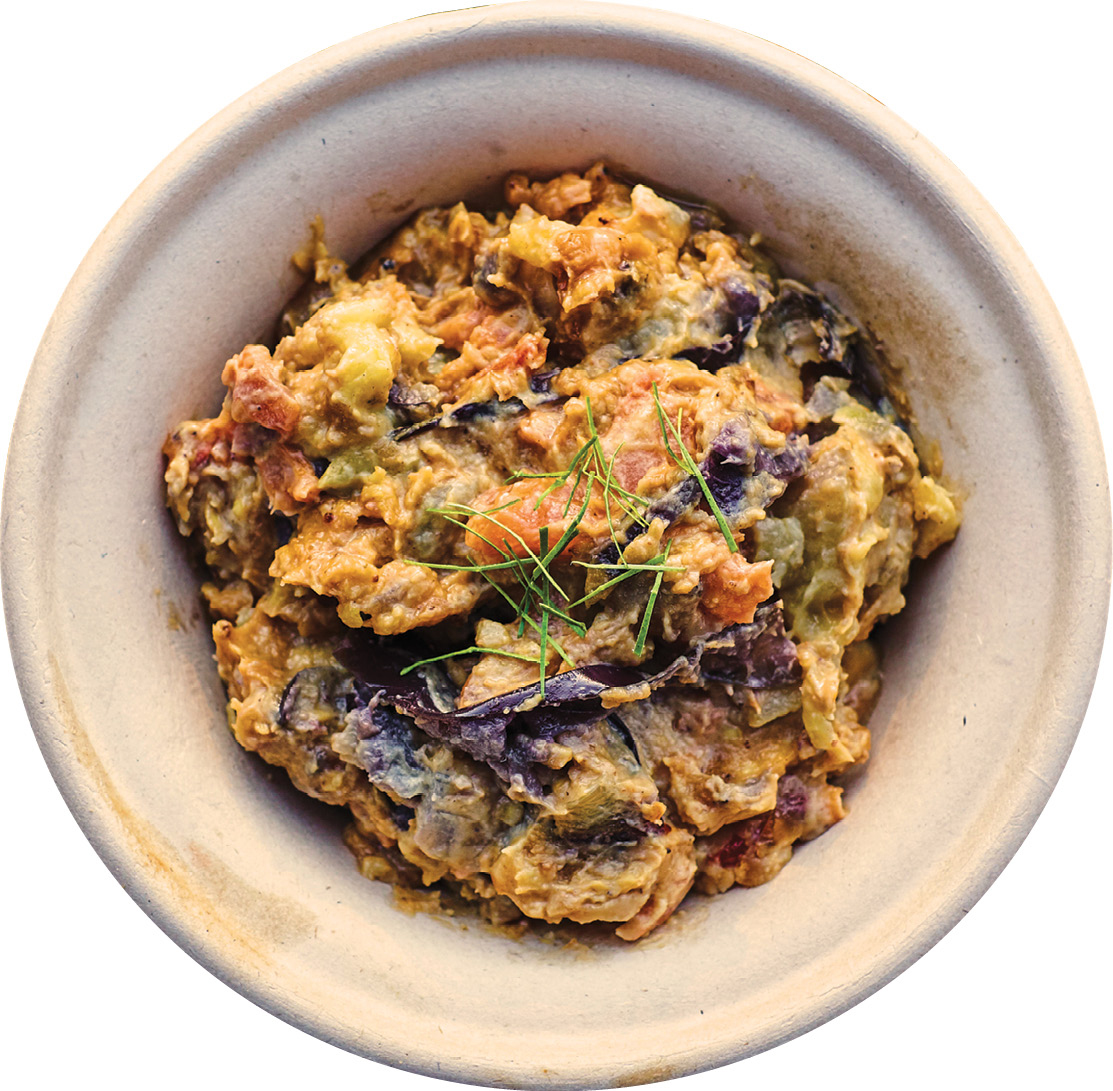
Gladys Shahtou
SAMBUXA NYC
24
SUDAN
Born in Khartoum, Sudan, in 1990, in the middle of the Second Sudanese Civil War, Gladys Shahtou nonetheless enjoyed a quiet, comfortable early childhood surrounded by a happy, internationally educated, socially engaged family, until one day in 1994, an officer came to their house looking for her father—a lawyer and political dissident, who quickly fled to Switzerland where he had missionary friends from his international advocacy work. “My grandpa was still working at the UN at the time in Ethiopia, so my mother, my brothers, and I left to Ethiopia, and then we all came to New York. . . . I mean obviously, you know, our family couldn’t be apart for too long, so we decided to move to be with my dad.”
As a four-year-old in Ethiopia, Gladys loved bringing her Ethiopian nanny’s injera to school for a delicious lunch, eaten carefully so as not to stain her all-white school uniform. As a five-, six-, seven-year-old in Astoria, Queens, Gladys attended PS 127, and gradually assimilated herself into the African American girls’ clique, learning to emulate their Queens accents. “I’m also a quarter Haitian—I thought we were all black. I didn’t understand the Oh, you’re African. You’re, like, not from here. . . . I didn’t get that, so I hung out with all the other black girls. I thought I was one of them.”
As an eight-year-old suddenly in Rafz, Switzerland, a small village near Zurich, Gladys had to start first grade all over again, for the third time now—this time in German. “It was hard. You just got used to a place. And Switzerland was totally different: It was like village life. Farms, new language—they didn’t know what Africans, or even African Americans, were.”
Her mother’s Sudanese samosas helped win the Swiss over, however. At school or office events or home birthday parties, whenever she made them “they would always disappear—fast—and that’s how we knew it wasn’t just us: They were really good.” Gladys had been helping her mother prep ingredients for as long as she could remember, but she wasn’t allowed to do the delicate dough folding until she was ten. It was a big deal for Gladys when she finally learned how to fold a samosa: Now she, too, had the power to bring people together with food.
Years later, while studying international relations at the University of Geneva and interning at the UN Human Rights Council, Gladys started making and selling samosas on the side. Thanks to a few connections made through her boss, there were soon several UN departments that knew and loved the taste of Sudanese samosas.
A few years later, nearing the end of a temporary position at the Swiss Mission to the UN in New York, Gladys was stumped when the resumes she sent out for her next job got no bites. “I applied to tons of jobs, and I got frustrated. In Switzerland, you can just send your CV around and people will answer yes or no, you know? But I didn’t get no answer, and that has never happened to me before. Based on just my qualifications. But I realized, in America it’s not like that. You have to know people, you have to network, you go for coffee breaks with your bosses—and in Switzerland we’re not used to that.”
After a brief stint working for the Democratic Party in DC, Gladys was back in NYC in 2017 when she started noticing all the food festivals. What if I had a little samosa stand? she thought. She got right to it—first at markets, then at larger events. People kept asking her, What else is on your menu? So she developed a more extensive menu based in the repertoire of Sudanese cuisine she had learned from her mother, mixing in some Haitian and Ethiopian dishes she had learned from her grandmother, and named her business Sambuxa—a name that just means “samosa” in Sudan but that any fellow Sudanese in New York would recognize.
In the past few years, Gladys has finally found home, not just in New York, but in a calling that brings her close to her Sudanese culture, working with her favorite foods, working with children, educating through nurturing, preserving, and promoting the culture she holds dear.
She remembers at thirteen her father, worrying his daughter was becoming too Swiss, suggested she dress more modestly and start wearing a headscarf, as Sudanese women do. She refused, with her mother’s blessing, but “every other nonreligious part of Sudanese culture my parents made sure I learned—and I cherish that so much.”
Gladys hopes in the next few years to find a way back to Khartoum, perhaps to start some kind of incubator and carry on her family’s advocacy legacy. “Khartoum still feels like home. And Zurich is home. And New York is home. They’re all home.”

Grandma “Mama” Gladys hosting a reception at home, serving fatayer (Sudanese empanadas)

SALATA DAKWA
Tomato Salad
Salata dakwa is a common Sudanese salad and something Gladys has made almost every single day since she was six years old: “Since I was the only girl in the family, it was my duty.” The salad can be flexible enough to include cucumbers or go without scallions, but it always has peanut butter. It is perfectly balanced, with sweetness from the peanut butter, fragrance from the cumin and sesame oil, zest from the lemon juice, and brininess from the “white cheese” (feta).
Makes 5 servings
1 bunch scallions, finely chopped
4 plum tomatoes, diced
1 cup (150 g) crumbled feta
3 tablespoons refined sesame oil
3 tablespoons unsalted creamy peanut butter
¼ cup plus 2 tablespoons (90 ml) warm water
¼ cup (60 ml) lemon juice
1 teaspoon ground cumin
1 teaspoon salt
1 teaspoon ground black pepper
Pita bread
1. Combine the scallions, tomatoes, and feta in a salad bowl. Add the sesame oil and mix.
2. In a separate bowl, dissolve the peanut butter in the warm water. Add the lemon juice, cumin, salt, and pepper and mix thoroughly.
3. Transfer the peanut butter dressing to the salad bowl and toss. Serve with a side of pita bread.

SALATA ASWAD
Eggplant Salad
The Arabic word for peanut literally means “Sudanese nut” or “Sudanese bean,” and as that might suggest, peanuts are integral to Sudanese cuisine, used in stews, sauces, and salads. According to Gladys, salata aswad is a bit like baba ghanoush but richer from the peanut butter, balanced out with acid from the tomatoes, and more texturally varied from the eggplant peels, onions, and tomatoes. Eat with pita bread or as a spread for sandwiches.
Makes 5 servings
½ cup (120 ml) sunflower or vegetable oil, plus more for frying the eggplant
2 medium black or purple eggplants, peeled and sliced into ½-inch (13 mm) thick half-moons
1 medium white onion, sliced into half-moons
1 or 2 garlic cloves, minced
1 tablespoon ground cumin
½ teaspoon salt
½ teaspoon ground black pepper
2 plum tomatoes, sliced into half-moons
3½ tablespoons unsalted creamy peanut butter*
2 tablespoons lemon juice
1. Pour about 1 to 2 inches (2.5 to 5 cm) oil into a deep pot and heat over medium-high heat to about 350°F (180°C). Fry the eggplant, in batches, until brown or slightly charred, about 2 minutes on each side. Remove from the pan and place on paper towels to drain.
2. Pour the ½ cup (120 ml) oil into a large pot over high heat. Add the onion and pan-fry until translucent, about 5 minutes. Add the garlic, cumin, salt, and pepper and stir to combine. Add the tomatoes, reduce the heat to medium, cover, and bring to a boil. Turn the heat to low and simmer, stirring occasionally, until the onions and tomatoes are stewed, about 10 minutes.
3. Melt in the peanut butter and add the eggplants to the pot. Add the lemon juice and mix well, mashing the solid pieces with a spoon, spatula, or masher as you stir. (You can also mash after the stew cools.)
4. Remove from the heat and let cool.
5. Serve chilled or at room temperature.

* While Sudanese peanut butter has an earthier, less salty, and less sweet taste than American versions, Gladys still uses American brands when cooking in the US. She thinks the difference isn’t so great as to warrant the difficult task of sourcing Sudanese peanut butter.